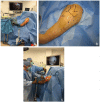Posterior Shoulder Instability
- PMID: 27697889
- PMCID: PMC5089362
- DOI: 10.1177/1941738116672446
Posterior Shoulder Instability
Abstract
Context: Posterior shoulder instability has become more frequently recognized and treated as a unique subset of shoulder instability, especially in the military. Posterior shoulder pathology may be more difficult to accurately diagnose than its anterior counterpart, and commonly, patients present with complaints of pain rather than instability. "Posterior instability" may encompass both dislocation and subluxation, and the most common presentation is recurrent posterior subluxation. Arthroscopic and open treatment techniques have improved as understanding of posterior shoulder instability has evolved.
Evidence acquisition: Electronic databases including PubMed and MEDLINE were queried for articles relating to posterior shoulder instability.
Study design: Clinical review.
Level of evidence: Level 4.
Results: In low-demand patients, nonoperative treatment of posterior shoulder instability should be considered a first line of treatment and is typically successful. Conservative treatment, however, is commonly unsuccessful in active patients, such as military members. Those patients with persistent shoulder pain, instability, or functional limitations after a trial of conservative treatment may be considered surgical candidates. Arthroscopic posterior shoulder stabilization has demonstrated excellent clinical outcomes, high patient satisfaction, and low complication rates. Advanced techniques may be required in select cases to address bone loss, glenoid dysplasia, or revision.
Conclusion: Posterior instability represents about 10% of shoulder instability and has become increasingly recognized and treated in military members. Nonoperative treatment is commonly unsuccessful in active patients, and surgical stabilization can be considered in patients who do not respond. Isolated posterior labral repairs constitute up to 24% of operatively treated labral repairs in a military population. Arthroscopic posterior stabilization is typically considered as first-line surgical treatment, while open techniques may be required in complex or revision settings.
Keywords: instability; posterior stabilization; shoulder arthroscopy.
Conflict of interest statement
The following authors declared potential conflicts of interest: John M. Tokish, MD, is a paid consultant for Arthrex and Depuy-Mitek and Brett D. Owens, MD, is a paid consultant for Mitek and MTF/Conmed.
Figures






References
-
- Barbier O, Ollat D, Marchaland JP, Versier G. Iliac bone-block autograft for posterior shoulder instability. Orthop Traumatol Surg Res. 2009;95:100-107. - PubMed
-
- Bottoni CR, Franks BR, Moore JH, DeBerardino TM, Taylor DC, Arciero RA. Operative stabilization of posterior shoulder instability. Am J Sports Med. 2005;33:996-1002. - PubMed
-
- Bradley JP, Baker CL, 3rd, Kline AJ, Armfield DR, Chhabra A. Arthroscopic capsulolabral reconstruction for posterior instability of the shoulder: a prospective study of 100 shoulders. Am J Sports Med. 2006;34:1061-1071. - PubMed
-
- Bradley JP, McClincy MP, Arner JW, Tejwani SG. Arthroscopic capsulolabral reconstruction for posterior instability of the shoulder: a prospective study of 200 shoulders. Am J Sports Med. 2013;41:2005-2014. - PubMed
Publication types
MeSH terms
LinkOut - more resources
Full Text Sources
Other Literature Sources
Medical
Research Materials

